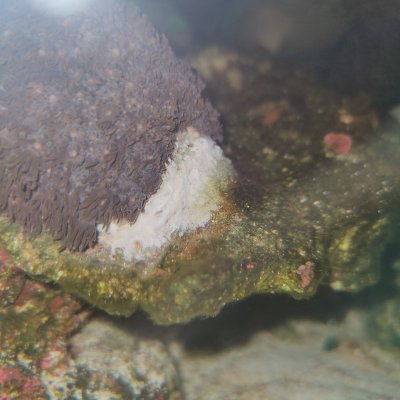Navigation
Install the app
How to install the app on iOS
Follow along with the video below to see how to install our site as a web app on your home screen.
Note: This feature may not be available in some browsers.
More options
You are using an out of date browser. It may not display this or other websites correctly.
You should upgrade or use an alternative browser.
You should upgrade or use an alternative browser.
No specific ID from me, but to tell if it's a problem sponge or not:
With regards to getting rid of it:Yeah, that's definitely a sponge. Most sponges are completely harmless/beneficial, but some can be invasive and/or harmful to corals (thankfully, these are rare).
To tell if a sponge is chemically harmful: if a healthy, established coral starts closing up or looking to be in bad shape on the side closest to the sponge as the sponge grows closer to it, and nothing else has happened (lighting changes, parameter swings, pests, etc.) that could explain it, then the sponge is probably chemically harmful.
Chemically harmful sponges are very rare.
For invasive sponges: unless it shows signs of being chemically harmful or starts actively growing over and smothering a coral's flesh/polyps, it's harmless. These can grow over the skeletons of corals, around the base/stalks of corals, even up into the water column above corals (where they're over the coral but not growing on the flesh or polyps themselves), etc. without harming the coral at all - as long as the coral flesh and polyps can get food, light, and flow, the sponge is harmless.
Invasive sponges are moderately rare.
Invasive and chemically harmful sponges are incredibly rare.
For removal:
I've heard of some good removal success rates with the injection method (described below), but that may be risky with the sponge being on the zoas.
The best way I've heard to control sponge growth at this point is to use a steel straw to scrape and siphon out the sponge you want to remove. Sometimes you can create bad conditions for them and kill them off that way, but that's typically much harder and not always effective.
I would try the scraping with a steel straw/brushing with a toothbrush and siphoning out for that one in particular - if you can do this is a bowl of saltwater out of the tank (I don't recommend adding the water to the tank after) and rinse with clean saltwater (not from the bowl) afterwards, that would be even better.
I should clarify here - the scraping and siphoning method I refer to literally siphons through the straw as you scrape to try and prevent spreading (this is also why I recommend doing this in a bowl outside of the tank).
Some other sponge removal methods:
Other suggestions include exposing the sponge to air (obviously not a guaranteed solution, and definitely not viable for this situation); hydrogen peroxide dipping the sponge (again, not viable here); injecting the sponge with hydrogen peroxide, vinegar, boiling water, or air; microbubbles in the display; and a few more. Predation is not usually a good solution for this issue
Basically, if the sponges have enough food and enough trace elements (which for most sponges includes silicates) to meet their needs, then you’ll see their populations booming.
If you can figure out what’s allowing them to thrive in your tank, then you can deal with that root cause and get rid of them.
To add, some sponges have incredible regenerative capabilities, so multiple removals may be necessary, and doing what you can to minimize the odds of remaining sponge cells ending up back in your tank is recommended:
Similar threads
- Replies
- 6
- Views
- 197













